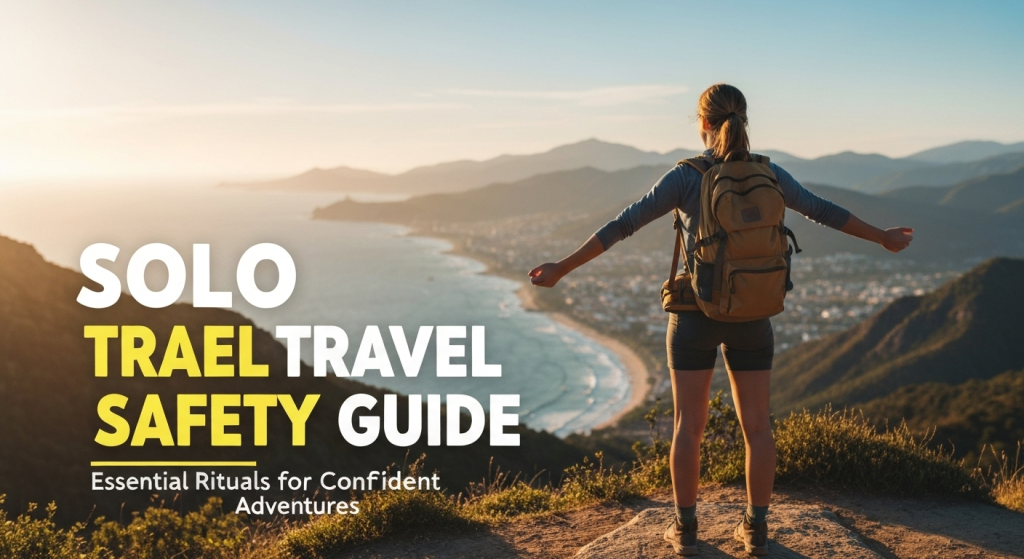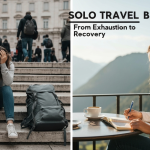Solo travel opens doors to incredible personal growth and unforgettable experiences. Yet safety concerns often hold people back from taking that first independent trip. After five years of solo adventures across 30+ countries, I’ve developed practical rituals that keep me safe while maintaining the freedom I crave.
My name is Mahnoor Farooq, and I’ve been a professional travel safety consultant for five years. Through my personal journeys and professional expertise, I’ve learned that feeling safe while traveling alone isn’t about avoiding risks entirely. It’s about smart preparation, trusting your instincts, and developing reliable safety habits.
Why Solo Travel Safety Matters More Than Ever
Solo travel has grown by 42% in recent years. More people are choosing independent adventures over group tours. This trend brings amazing opportunities but also unique challenges.
When you travel alone, you become your own security team. You make all decisions. You watch your belongings. You navigate unfamiliar places without backup. This responsibility can feel overwhelming, but it’s also empowering when you’re prepared.
The key lies in developing personal safety rituals. These aren’t paranoid precautions. They’re smart habits that let you explore confidently while staying protected.
Pre-Travel Safety Preparation: Building Your Foundation
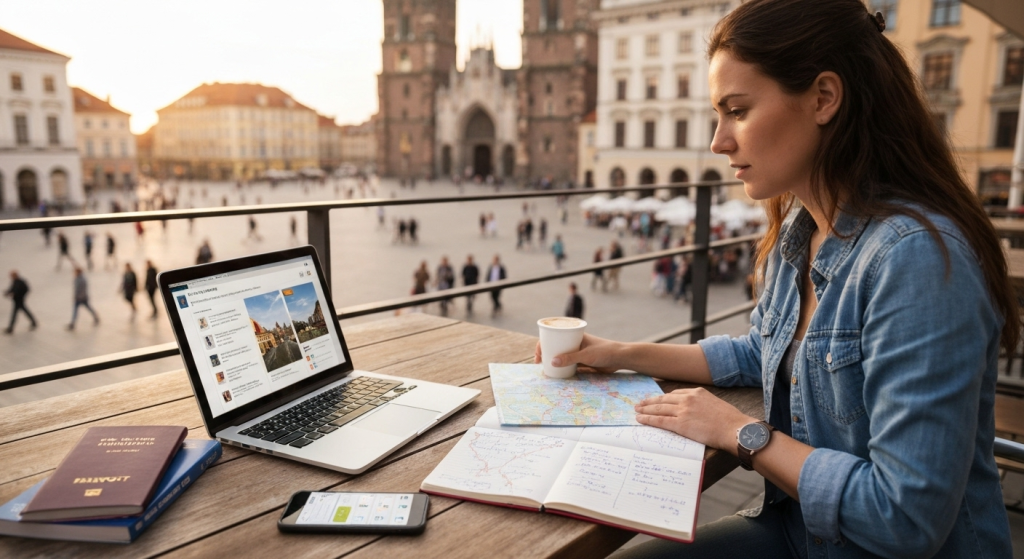
Research Your Destination Thoroughly
I spend at least two weeks researching every destination before I arrive. This isn’t just reading travel guides. I dig deeper into current safety conditions, local customs, and potential challenges.
My research process includes checking government travel advisories, reading recent traveler reports, and connecting with locals through online communities. I identify safe neighborhoods, reliable transportation options, and emergency contacts before I pack my bags.
Essential Research Areas:
- Current political climate and safety conditions
- Common scams targeting tourists
- Cultural norms and appropriate behavior
- Emergency services and hospital locations
- Reliable transportation options
- Safe areas for solo travelers
Create Multiple Backup Plans
Solo travelers can’t rely on companions for support when things go wrong. I always create backup plans for my backup plans.
For every booking, I research alternatives. If my accommodation falls through, I know three other safe options. If transportation gets canceled, I have alternative routes mapped out. This preparation reduces stress and keeps me flexible when unexpected situations arise.
| Situation | Primary Plan | Backup Option 1 | Backup Option 2 |
|---|---|---|---|
| Accommodation | Hotel booking | Verified hostel | Emergency Airbnb |
| Transportation | Scheduled flight | Alternative airline | Ground transport |
| Money Access | Primary bank card | Secondary card | Emergency cash |
| Communication | Cell phone | Backup phone | Local SIM card |
Daily Safety Rituals That Actually Work
Morning Security Check
Every morning, I perform a five-minute security check. This ritual has become second nature and catches potential problems early.
I check my belongings, review my day’s plans, and assess my surroundings. I make sure my phone is charged, my backup payment methods work, and someone knows my itinerary.
This simple routine prevents most travel disasters. It’s caught everything from pickpocket attempts to booking mistakes before they became serious problems.
The Buddy System for Solo Travelers
Even when traveling alone, I maintain connections with people who know my whereabouts. I’ve developed a check-in system with trusted contacts back home.
Every evening, I send a brief update to my designated emergency contact. If I’m doing something higher-risk, I check in more frequently. This isn’t helicopter parenting. It’s smart risk management.
My emergency contact has copies of my important documents, my itinerary, and clear instructions for what to do if they don’t hear from me. This system has helped fellow travelers during emergencies, and it gives my family peace of mind.
Trusting Your Instincts
After years of solo travel, I’ve learned that gut feelings are rarely wrong. If something feels off, it probably is. I’ve avoided countless problematic situations by simply trusting my initial instincts.
This doesn’t mean being paranoid about every interaction. It means paying attention to subtle warning signs and acting on them immediately. Your subconscious picks up on details your conscious mind might miss.
Communication and Documentation Strategies
Staying Connected Safely
Reliable communication is your lifeline during solo travel. I maintain multiple ways to stay connected, even in remote areas.
I carry a primary smartphone with international roaming, a backup phone with local SIM cards, and offline communication tools. I also identify WiFi locations in advance and know how to access emergency services in each destination.
Communication Toolkit:
- International phone plan with data
- Backup device with local connectivity
- Offline maps and translation apps
- Emergency contact information in local language
- Portable charger and universal adapter
Document Management System
I’ve developed a comprehensive document management system after learning the hard way during a passport emergency in Thailand.
I keep digital copies of everything in secure cloud storage. I also carry physical copies stored separately from originals. This system has saved me time, money, and stress during various travel complications.
Important documents get stored in three places: with me, in my luggage, and in secure cloud storage. I can access everything from any internet connection worldwide.
Accommodation Safety: Choosing and Securing Your Space
Selecting Safe Accommodations
Not all accommodations are created equal for solo travelers. I’ve developed specific criteria for choosing safe places to stay.
I prioritize locations with good lighting, multiple exit routes, and 24-hour reception. I read reviews specifically from other solo travelers, paying attention to safety concerns rather than just comfort ratings.
Accommodation Safety Checklist:
- Well-lit entrance and common areas
- Secure door locks and window latches
- 24-hour front desk or security presence
- Safe neighborhood location
- Positive reviews from solo travelers
- Multiple exit routes
Room Security Rituals
Once I arrive at any accommodation, I perform a standard security assessment. I check door locks, window security, and emergency exits. I locate the nearest fire escape and test all locks.
I also establish my daily security routine immediately. I designate specific places for valuables, set up my portable door alarm, and ensure my room number isn’t visible to casual observers.
These habits take five minutes but provide hours of peace of mind.
Transportation Safety: Moving Smart and Secure
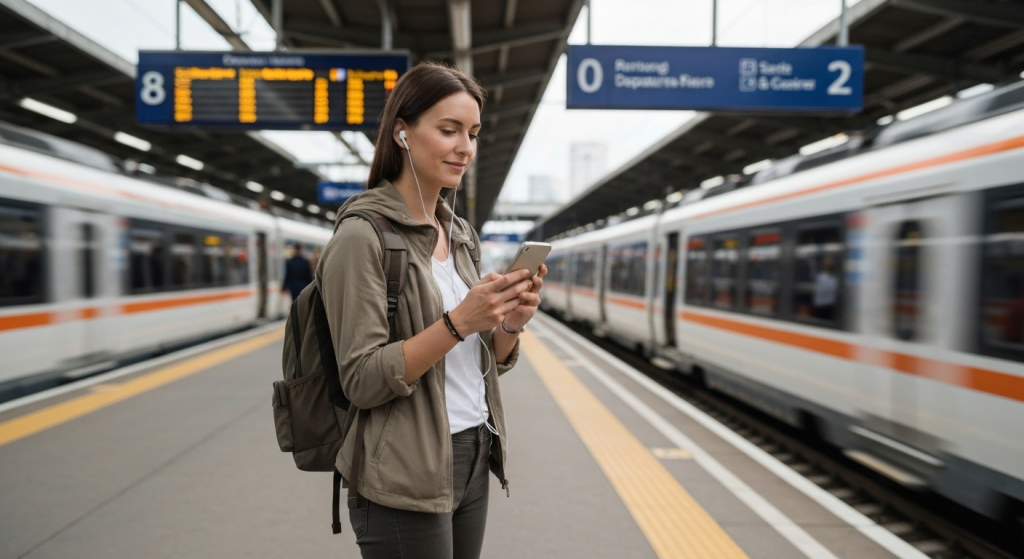
Public Transportation Strategies
Public transportation can be the safest and most economical way to travel solo, but it requires specific strategies.
I research transportation systems before arrival. I identify safe stations, peak travel times, and common issues. I always have offline maps and alternative routes planned.
During actual travel, I stay alert without being obvious about it. I position myself strategically, keep belongings secure, and maintain awareness of my surroundings.
Rideshare and Taxi Safety
Rideshare services have made solo travel much safer, but they still require caution. I verify driver and vehicle information before getting in any car.
I sit behind the driver when possible, share my ride details with my emergency contact, and keep the app open during the entire trip. If something feels wrong, I’m prepared to exit safely.
Rideshare Safety Protocol:
- Verify driver name, photo, and license plate
- Share ride details with emergency contact
- Sit strategically with easy exit access
- Keep app open and GPS tracking active
- Trust instincts if situation feels unsafe
Money and Valuables Management
Multiple Payment Methods
Financial security requires redundancy. I never rely on a single payment method during solo travel.
I carry multiple payment cards from different banks, keep emergency cash in various currencies, and maintain access to emergency funds through multiple channels.
This approach has prevented financial disasters during bank holidays, card malfunctions, and ATM shortages in remote locations.
| Payment Type | Primary | Backup 1 | Backup 2 |
|---|---|---|---|
| Credit Cards | Main travel card | Secondary credit card | Emergency card |
| Cash | Local currency | USD backup | Hidden emergency stash |
| Digital | Mobile payment app | Online banking | Emergency transfer service |
Valuables Protection System
I’ve learned to travel light and secure. Most valuables stay home. What I do bring gets protected through multiple security layers.
I use a combination of body-worn security, room safes, and distributed storage. No single theft or loss can compromise my entire trip.
My valuable items get distributed across different bags and locations. If one security layer fails, others remain intact.
Cultural Awareness and Adaptation
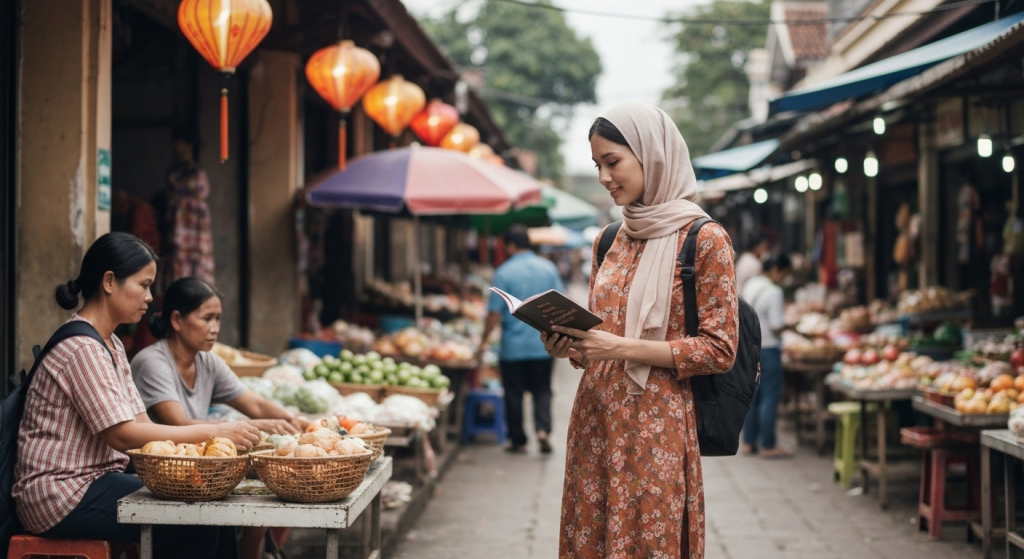
Understanding Local Safety Norms
Every destination has unique safety considerations based on local culture and conditions. What works in one place might create problems in another.
I research cultural norms around solo travel, especially as a woman. I understand local attitudes toward independent travelers and adjust my behavior accordingly.
This isn’t about changing who I am. It’s about respecting local customs while maintaining my safety and comfort.
Blending In Effectively
Standing out as a tourist makes you a target for scams and crimes. I’ve learned to blend in without compromising my authentic travel experience.
I observe local dress codes, behavior patterns, and social norms. I avoid obvious tourist behaviors like constantly checking maps or wearing expensive jewelry.
The goal is appearing confident and purposeful rather than lost and vulnerable.
Emergency Preparedness and Response
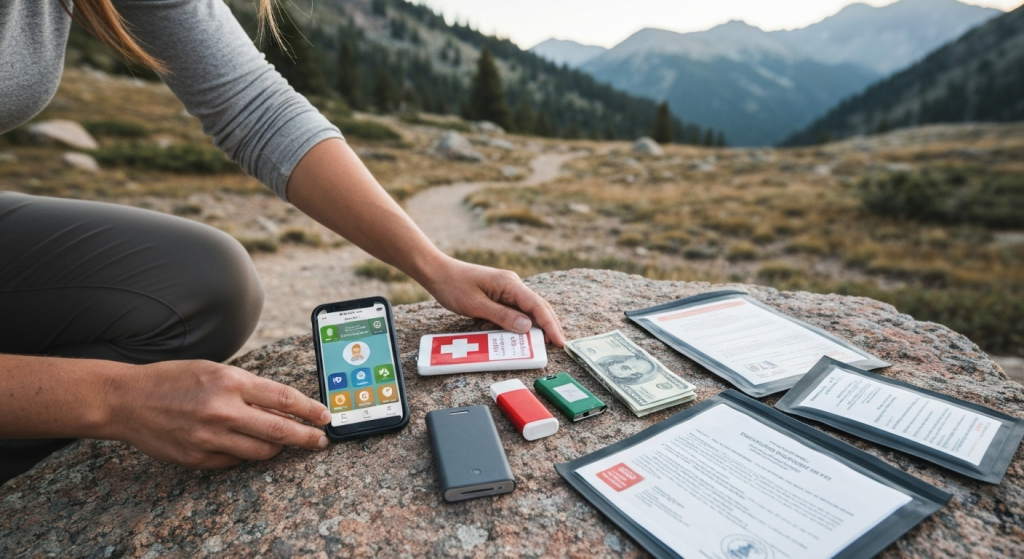
Creating Emergency Action Plans
I prepare for various emergency scenarios before they happen. This preparation allows me to respond quickly and effectively when situations arise.
My emergency plans cover medical issues, natural disasters, political instability, and personal security threats. Each plan includes specific actions, contact information, and evacuation procedures.
Emergency Response Categories:
- Medical emergencies and healthcare access
- Natural disasters and extreme weather
- Political instability and civil unrest
- Personal security threats and crime
- Financial emergencies and document loss
Emergency Kit Essentials
I carry a compact emergency kit containing items that could be life-saving during various crises.
This isn’t a massive survival kit. It’s a carefully selected collection of items that address the most likely emergency scenarios during solo travel.
My kit includes first aid supplies, emergency medications, emergency cash, backup communication devices, and important document copies.
Building Confidence Through Experience
Starting Small and Building Skills
Solo travel confidence develops through experience. I recommend starting with easier destinations and gradually taking on more challenging adventures.
My first solo trip was a domestic weekend getaway. Each subsequent trip built on previous experiences and pushed my comfort zone slightly further.
This gradual progression builds real confidence based on actual skills rather than false bravado.
Learning From Mistakes
Every solo traveler makes mistakes. The key is learning from them without letting them destroy your confidence.
I’ve made plenty of errors during my solo travels. Each mistake taught me something valuable about safety, preparation, or risk assessment.
These experiences made me a better, safer traveler. They also proved that most travel mistakes are survivable and educational.
Technology Tools for Solo Travel Safety
Essential Safety Apps
Technology can significantly enhance solo travel safety when used properly. I rely on several apps that provide security features and emergency assistance.
These tools complement, but don’t replace, good judgment and proper preparation. They’re most effective when integrated into comprehensive safety planning.
Recommended Safety Apps:
- Offline maps and navigation tools
- Translation apps with offline capability
- Emergency contact and location sharing
- Local emergency services information
- Travel insurance and assistance apps
Digital Security Measures
Online safety becomes crucial during solo travel. I protect my digital information as carefully as my physical belongings.
I use VPN services on public WiFi, enable two-factor authentication on important accounts, and keep software updated. I also backup important data before traveling.
These measures protect against identity theft, financial fraud, and privacy violations.
Health and Medical Safety
Medical Preparation
Health emergencies can be especially challenging for solo travelers. I prepare extensively for potential medical issues.
I research healthcare systems at my destination, locate recommended hospitals and clinics, and understand insurance coverage. I also pack a comprehensive medical kit and carry emergency medical information.
This preparation has helped me handle everything from minor injuries to serious illnesses during solo trips.
Mental Health Considerations
Solo travel can be emotionally challenging. I’ve learned to recognize and address mental health issues that can arise during independent travel.
I maintain routines that support mental wellbeing, stay connected with support networks back home, and know when to seek professional help.
Mental health is as important as physical safety during solo travel.
Frequently Asked Questions
Is solo travel actually safe for beginners? Solo travel can be very safe with proper preparation and common sense. Start with easier destinations and gradually build your experience and confidence.
How do I stay safe as a solo female traveler? Female solo travelers need additional precautions around accommodation choices, transportation, and cultural sensitivity. Research local attitudes and adjust behavior accordingly while maintaining your independence.
What should I do if something goes wrong during solo travel? Stay calm, follow your emergency plans, and contact your support network immediately. Most travel problems have solutions if you remain flexible and seek appropriate help.
How much should I budget for solo travel safety measures? Safety investments like travel insurance, quality accommodations, and reliable transportation typically add 10-20% to your travel budget but provide invaluable peace of mind and protection.
Conclusion
Solo travel safety isn’t about avoiding all risks. It’s about managing risks intelligently while maintaining the freedom and growth that make independent travel so rewarding.
These safety rituals have allowed me to explore the world confidently while staying protected. They’re based on real experience, not theoretical fears.
Start implementing these strategies gradually. Build your confidence through experience. Trust your instincts, prepare thoroughly, and embrace the incredible journey that solo travel offers.
The world is waiting for you. With proper preparation and smart safety habits, you can explore it safely and confidently on your own terms.

